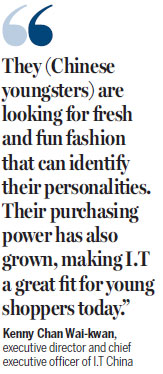Fashion icon on a 'shopping honeymoon'
Updated: 2017-07-14 06:05
By Evelyn yu in Hong Kong(HK Edition)
|
|||||||||
HK apparel chain I.T says mainland youngsters now embracing its labels that offer 'inspiration'
Hong Kong fashion icon I.T Ltd boasts having sunk its roots well in the vast Chinese mainland market since making its first bold move in 2002 when it launched its maiden store in Shanghai.
With more than 550 stores now in full swing across 28 mainland cities, the apparel chain is pulling out all the stops in backing up the momentum, saying Hong Kong's adverse economic climate - soft consumer pace plus towering rents and labor costs - is not giving it the comfort it needs.

In its annual report issued in June, I.T recorded a 16-percent jump in total sales on the mainland to HK$3.5 billion, against a 6.3-percent drop in sales to HK$3.2 billion in Hong Kong, attributed to an ongoing retail slump. The group's net profit soared 50 percent to HK$315 million amid a HK$65-million foreign exchange loss as a result of the conversion of the group's renminbi deposits into Hong Kong dollars the previous year.
Government statistics showed that the SAR's retail business - one of the worst-hit trades since tourist arrivals, notably from the mainland, slowed drastically in the past few years - experienced an 8-percent, year-on-year plunge in 2016 - a 17-year low - while sales of clothing dipped 5.1 percent over the previous year's.
I.T runs a unique, multi-brand and multi-layer business mode featuring a combination of in-house and licensed global brands.

Its 10 in-house labels, including 5cm, izzue, :CHOCOOLATE, b+ab and AAPE, are all the rage among young customers. The chain also offers an array of inventive labels from around the world, both established and emerging, and has more than 300 brands at either its flagship multi-brand stores or exclusive shops.
Kenny Chan Wai-kwan, executive director and chief executive officer of I.T China, told China Daily that while in-house brands make up 60 percent of the group's revenue, the international brands account for the other 40 percent.
Behind the success of its hundreds of world labels is the fashion buying system that Chan is proud of.
I.T has more than 50 fashion buyers, while its fashion scouts, with their eyes glued to the worldwide fashion trend and being able to anticipate the desirability of apparels and accessories, are bringing a steady stream of inspirational brands into the company's portfolio.
I.T has nurtured many unknown brands that were once new and unknown, like Kenzo, whose tag could only be seen at just a few exclusive shops on the mainland years ago. The group's extensive distribution channels have helped the brand find its way into the mainland's critical masses. Kenzo's symbolic tiger-motif sweatshirt is a now a "must have" for many young Chinese people.
Chan believes that fashion buying, which provides better varieties to customers, serves as a good alternative to the traditional department stores that house repetitive brands and collections.
In 2013, I.T opened upmarket department store Galeries Lafayette through a 50-50 joint venture with the French company. Galeries Lafayette's 10-story store in Paris is a major attraction for Chinese tourists. Yet, when the fashion store, known for its exclusive couture selections, entered the mainland market, it didn't make the grade, recording millions of yuan in losses in its first two years of operation.
But, Chan thought it was normal as it would take time for Chinese consumers to accept new things, adding that the shopping mall is the black this year.
He recalled I.T's 15 years operating on the mainland, saying it had been a hard time with a Hong Kong enterprise venturing into a new economy it barely knew.
"More than 10 years ago, when we opened the first store in Shenyang, we had no idea that people in northeastern China preferred colorful costumes. Our collections, mostly in black, white and grey, didn't appeal to them. The overcoats were not thick enough against the severe cold, nor did the size of Hong Kong clothings fit the taller people in the northeastern region. The business was tough and we were forced to shut it down."
With 15 years of careful research, Chan said, I.T has got to know the regional characteristics and local people's preferences in each city and will now remind various designers with the aim of reaching out to mainland shoppers.
"Today, Chinese youngsters are shrewd, fully conscious of the latest trends in China and overseas. They are looking for fresh and fun fashion that can identify their personalities. Their purchasing power has also grown, making I.T a great fit for young shoppers today."
The group's latest addition has been a store over 2,000 square meters which opened in Hangzhou last month. It has also acquired a piece of land in Kunshan - a county-level city adjacent to Shanghai - as its logistics center which, upon completion in 2019, is expected to keep logistics costs down.
I.T seeks to expand its foothold in mainland cities both new and old. "In three to five years, we hope to see new stores in 36 cities, basically covering every province. We're also looking for potential three and four-tier cities to showcase our newly created in-house brands," said Chan.
"After years of painstaking efforts, we've found solace. We've finally entered into the honeymoon phase with Chinese shoppers."
evelyn@chinadailyhk.com

(HK Edition 07/14/2017 page8)